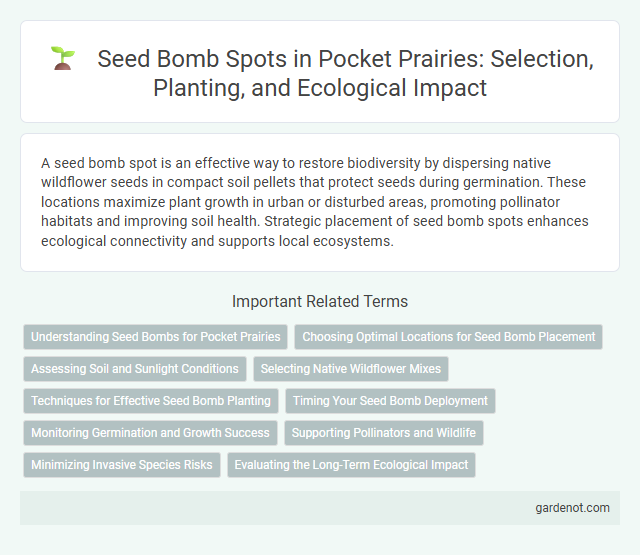A seed bomb spot is an effective way to restore biodiversity by dispersing native wildflower seeds in compact soil pellets that protect seeds during germination. These locations maximize plant growth in urban or disturbed areas, promoting pollinator habitats and improving soil health. Strategic placement of seed bomb spots enhances ecological connectivity and supports local ecosystems.
Understanding Seed Bombs for Pocket Prairies
Seed bombs consist of a compact mixture of native prairie seeds, clay, and compost designed to promote germination in disturbed soils. These seed bombs enable easy dispersal and protection of seeds, increasing the success rate of establishing diverse native plants in pocket prairies. Understanding the composition and deployment methods of seed bombs is essential for fostering sustainable urban green spaces that support local biodiversity.
Choosing Optimal Locations for Seed Bomb Placement
Selecting optimal locations for seed bomb placement enhances the success of pocket prairie restoration by targeting areas with sufficient sunlight, minimal foot traffic, and suitable soil conditions. Prioritize open spaces near native plant populations to increase pollinator visits and biodiversity. Avoid compacted or shaded sites, as these hinder seed germination and growth.
Assessing Soil and Sunlight Conditions
Seed bomb spot selection requires careful assessment of soil quality and sunlight exposure to ensure successful germination and growth. Ideal soil for a pocket prairie should be well-drained with moderate fertility, while full to partial sunlight promotes diverse native plant species establishment. Testing soil pH and texture along with observing daily sunlight patterns helps identify optimal locations for seed bomb deployment, maximizing prairie restoration success.
Selecting Native Wildflower Mixes
Selecting native wildflower mixes for seed bomb spots ensures local ecosystem compatibility and supports pollinator populations effectively. Choosing species adapted to the regional climate and soil enhances germination rates and long-term sustainability of pocket prairies. Native wildflower mixes also increase biodiversity, attracting beneficial insects and improving soil health.
Techniques for Effective Seed Bomb Planting
Seed bomb planting techniques maximize germination by selecting nutrient-rich soil spots with adequate sunlight exposure. Targeting areas with minimal weed competition ensures better seed establishment and growth. Using moisture-retentive soil amendments further supports seed hydration for successful sprouting in pocket prairies.
Timing Your Seed Bomb Deployment
Timing your seed bomb deployment in a pocket prairie is crucial for maximizing seed germination and plant establishment. The best time to scatter seed bombs is during early spring or late fall when soil moisture is naturally higher, and temperatures are moderate, promoting optimal seed-to-soil contact and growth conditions. Avoiding extreme heat and drought periods enhances the success rate of seed bombs in restoring native prairie vegetation.
Monitoring Germination and Growth Success
Seed bomb spots require careful monitoring of germination rates and growth success to ensure effective restoration of native plant species in pocket prairies. Regular observations track seedling emergence, soil moisture levels, and growth progress, providing essential data to adjust management practices. Documented success in germination and plant development supports the overall health and biodiversity of the pocket prairie ecosystem.
Supporting Pollinators and Wildlife
Seed bomb spots in pocket prairies provide essential habitats that support pollinators such as bees, butterflies, and hummingbirds by offering diverse native flowering plants crucial for nectar and pollen. These areas enhance local biodiversity, creating food sources and shelter for various wildlife, including beneficial insects and small mammals. By facilitating natural plant regeneration, seed bomb spots strengthen ecosystem resilience and promote sustainable pollinator populations.
Minimizing Invasive Species Risks
Seed bomb spots designed for pocket prairies prioritize native plant species to minimize the risk of invasive species establishment. Careful selection of seed mixes containing local genotypes ensures ecosystem compatibility and supports biodiversity. Regular monitoring and adaptive management prevent the encroachment of invasive plants, safeguarding habitat health.
Evaluating the Long-Term Ecological Impact
Seed bomb spots enhance native biodiversity by facilitating the natural regeneration of native plants in degraded areas. Long-term ecological impact evaluation involves monitoring species diversity, soil health, and habitat connectivity over multiple growing seasons. Data collected guides adaptive management strategies to maximize restoration success and ecosystem resilience.
Seed bomb spot Infographic

 gardenot.com
gardenot.com